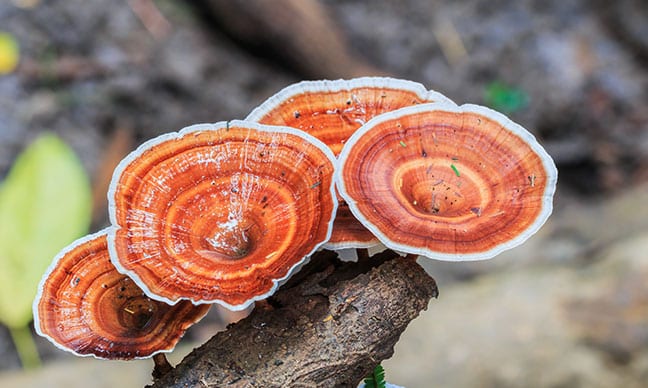Tree fungus is a common phenomenon in Texas, one that the residents have battled for decades. Gardeners spend thousands of dollars every year on tree fungus treatment and those who are not so lucky watch helplessly as their trees succumb to these deadly monsters.
If you are planning on adding trees to your Texas property, it is important that you do your research on the most common tree fungus Texas residents deal with and how to manage them. And this post is just the right place to start!
Related Post: Tree Diseases Texas
5 Types Of Tree Fungus Texas Homeowners Should Know About
There is an abundance of fungus that can affect the health of trees in Texas. We have listed the most common below and how to control them.
1. Oak Leaf Blisters
As the name suggests, oak leaf blisters mostly occur in oaks, white and red oaks being the most affected. When it attacks, it causes the cells of the leaves to enlarge and divide abnormally. As a result, yellow protrusions that appear blister-like form on the upper surface of the leaf.
As the fungus continues to multiply, the blisters merge and cause the leaf to coil. Eventually, the leaf detaches from the branch. The more the tree loses its leaves, the more it is unable to make its own food and with time, it starts to die.
Sadly, once defoliation starts, very little can be done to save the tree. The only way to prevent this from happening is by keeping funguses at bay by spraying your trees with pesticides and having a tree service Texas company check them regularly.
2. Ganoderma
Ganoderma affects the roots and trunks of various tree species including the oaks, ash, and elms. The infected tree exhibit yellowing, branch dieback, withering, undersized leaves, and general weakness. Though the tree may remain this way for up to five years, it eventually dies.
To prevent, this fungus, avoid injuring the roots and trunks of your tree. This is because the fungus spreads when the fungal spores carried by wind penetrate through an open wound. If you have a wounded tree in your yard, have it treated right away.
Ganoderma is one of the most common tree diseases in Dallas, Fort Worth Area, and affects 36% of oaks and elms every year. It has also terrorized trees in Austin and Denton, making it one of the Texas tree fungus that gardeners should be concerned about.
3. Hypoxylon Canker
Another tree fungus Texas residents have been battling for centuries is the hypoxylon canker. This one invades trees that are stressed and those with weak immunity. The fungus enters the plant through the wounded surfaces on the trunk or branches.
The first sign of hypoxylon canker is yellowing of the leaves which is followed by a branch dieback. This dieback progresses from limb to limb until the entire tree dies. When the tree is almost dead, its bark falls off, revealing brown spores. A few weeks later the spores disappear exposing silver grayish wood. Eventually, the wood turns black.
Not even the strongest treatment will work on hypoxylon canker. The most effective way to prevent it is by keeping your trees healthy.
Related Post: Texas Shade Trees
4. Actinopelte Leafspot
Those large brown spots you see on the leaf margin of your Austin trees are actually a type of fungi as well. Actinopelte leafspot targets the oaks but the read oak has been found to be the most affected, hence this oak variety may not be among the best trees to plant in Austin.
When the infection worsens, the tree begins to lose its leaves, hindering its ability to manufacture its own food. Young plants and those with weakened immune system, appear to be the most damaged.
To prevent damage, water your trees and apply fertilizer properly. There are plenty of companies that can help with tree fertilization in Austin. Have one test your soil to find out which nutrients are lacking so they can administer the most appropriate fertilizer to replace those nutrients.
5. Oak Wilt
Oak wilt strikes live oaks and red oaks, causing their leaves to turn brown and detach from the limbs. The fungus is spread through beetles and root grafts, which is why it is important to spray pesticides regularly. Also, make sure all your grafting is done by a professional.
We rank oak wilt among the most fatal Texas tree fungus because like all the fungi we have listed above, it is not curable. The only way to keep your tree from dying is by preventing it by maintaining you trees in good health.
What Does Oak Tree Fungus Look Like?
Oak tree fungus is usually characterized by leaf discoloration and withering. When it just strikes, the rich green color of the leaves starts to fade beginning from the upper part of the tree. Keeping your oaks healthy will help prevent fungus. But once the tree has been infected, it can’t be saved. You can only prolong its life by applying pesticides.
What Kills Fungus On Trees?
The most effective way to kill fungus on trees is by applying fungicides. However, you need to choose one meant for the type of fungus you are treating. Also, read the instructions to know whether the fungicide is sprayed on the branches and leaves or watered into the roots. Stick to the treatment schedule as instructed on the package.
How Do You Treat Tree Trunk Fungus?
To treat tree trunk fungus, spray the infected tree with copper sulfate. This should be done when the weather is warm preferably between late spring and early fall. You can also use lime sulfur. Whichever product you choose, however, make sure you are not applying to the leaves or roots, as this can cause damage to the tree.
The Local Tree Experts Overview
Homeowners dread tree fungus because they know the kind of damage they can do to a greenery. We have highlighted a few tree fungus Texas gardeners are afraid of and how to manage them. But any tree expert will tell you that the best way to avoid losing a tree to fungi is to keep the tree in a healthy condition.




